Molo Kunjani, That’s how we say it in Xhosa !
Before the last part of our journey, we turn to the Augrabies Falls National Park in the Northern Cape province, 494 miles North of Cape Town and 560 miles South of Johannesburg. The Park was established in 1966 and covers an area of 320 square miles. The Augrabies Falls National Park stretches 31 miles along the Orange River and is home to spectacular, but not very powerful falls in the winter season as well as a unique ecosystem. The Orange River is the longest river in South Africa with a total length of 1,400 miles. Its source in the Drakensberg mountains in Lesotho and it flows westwards through South Africa, forming part of the border between South Africa and Namibia. In the Park, the Orange River falls 197 feet into a gorge that had been eroded in the granite over 500 million years by powerful and rumbling waters. Multicolored lizards, an endemic species, stand out against the pink granite adjacent to the falls, while flocks of birds hunt insects between the rock walls.
After a few hours hike, a strange and magnificent mineral universe has been unveiled. On the horizon the black tone of the numerous hills contrasts with the hue of orange-red rocks. These volcanic rock formations refuse categorically to erode as fast as their neighbors. As a protective skin, they have particles of iron, manganese, and titanium… much better, I must confess, than any anti-aging cream. We climb a rocky peak, which sticks out between the arms of the river at the confluence of the two canyons. The view is marvelous, and new waterfalls unfold in front of us.
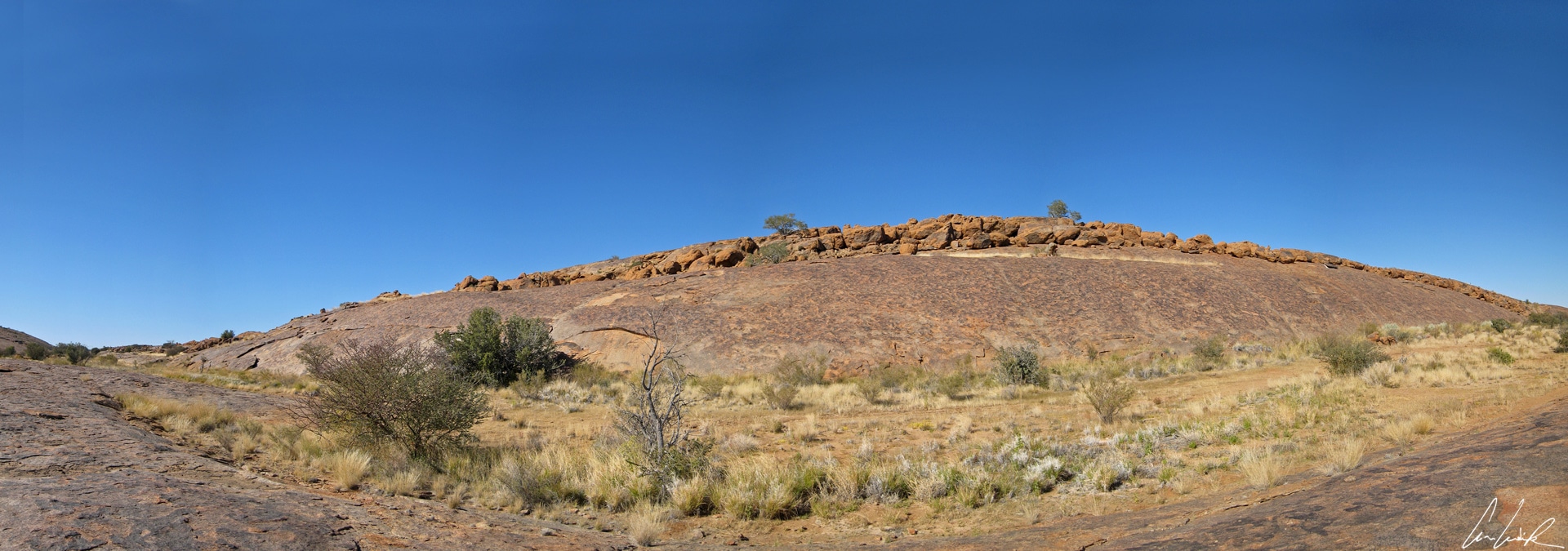
Augrabies Falls National Park, Moon Rock
One of the landmarks in the Augrabies Falls National Park is Moon Rock, a sort of granite dome three-quarters buried and measuring nearly 2,300 feet by 330 feet and 98 feet high. A closer look reveals an onion-like structure, as the upper layer cracks it exposes another layer below. Numerous trails wind through the mountains where vines and giant aloes (Aloe Dichotoma), also known as the quiver tree or kokerboom, grow. The treelike aloes are indigenous to the Northern Cape region and perfectly adapted to the arid climate. These eye-catching branching aloes grow up to 16 feet high. In Afrikaans “koker” mean quiver and “boom” tree. Its name comes from the fact that the indigenous San people, also known as Bushmen or Basarwa use its branches and bark to make quivers for holding their arrows. In this magnificent scenery, we meet some peculiar inhabitants… a Steenbok follows us at a distance. We are undoubtedly in its territory. This superb small antelope, standing between 16 and 24 inches at the shoulder is recognizable by its large ears with finger-marks on the inside and large eyes that confer a gentle look. And suddenly, “horresco reference” a group of giraffes stands a few steps away from us… There, is that not a calf ? We are speechless at this unexpected encounter, just like this Vervet.

Augrabies Falls National Park, Calf
We are off on the final step of our journey, the semi-arid Kalahari Desert. Objective Dune, as Hergé would say ! Kalahari is derived from the Tswana word “Kgala” meaning “Great thirst” or “Kgalagadi” meaning “waterless place.” It covers an area of 350,000 square miles between the Zambezi and Orange river basins, covering much of Botswana as well as southeastern Namibia and northwestern South Africa. The Kalahari is characterized by vast areas of red sand. It is native to the Kori bustard, the largest and heaviest flying bird in Africa! The never-ending sea of reddish sand stretches as far as the eye can see and creates an impression of emptiness, but this is only “The Great Illusion”.

The semi-arid Kalahari Desert, Kori bustard
The fauna of the Kalahari are profuse, and animals move freely from one country to another. Large herds of herbivores such as Bubal, Wildebeest or Springboks (but without their oval balloons and green and gold sweaters) crisscross the desert in search of water and young shoots. Whether to escape or to play, the Springbok performs incredible multiple leaps in the air, head bent downward, body arched and legs stiff. The name springbok comes from the Afrikaans words “spring” meaning jump and “bok” meaning goat and literally means “the goat that jumps.” Another small mammal found in this vast area of red sand and dry grasses with a few thorny trees thrown in is the Yellow Mongoose, also called the Red Meerkat, belonging to the Suricate family (as in the French film with the same name by the trio of French humorists !)
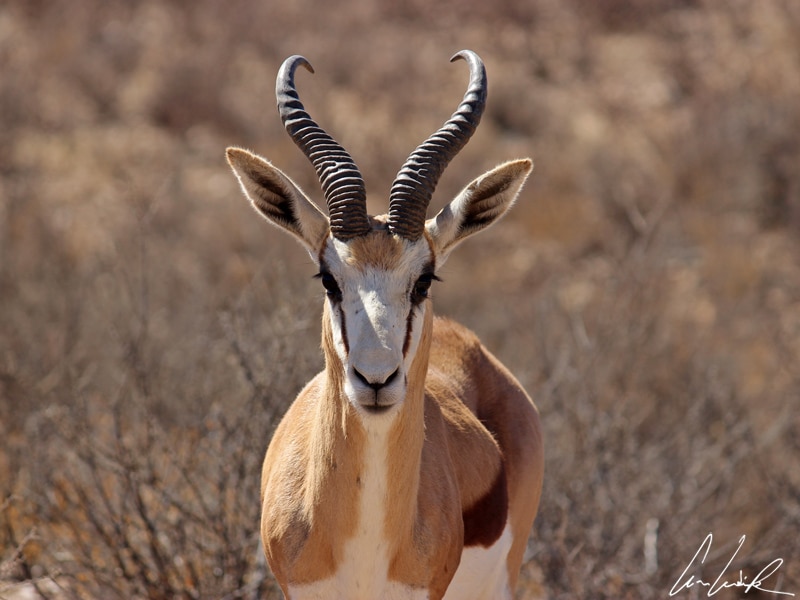
The semi-arid Kalahari Desert, Springbok
The enormous flocks of herbivores found in the desert are followed closely by colonies of insects and predators… The Black-backed Jackal is recognizable by its reddish coat and a black saddle that extends from the neck to the base of the tail. Its name comes from the Turkish word “çaprak,” which designates the sheepskin cover Napoleon’s hussars used under their saddles. Depending on the species the hunting technique differs, but typically the Black-backed Jackal chases its prey until exhaustion, then bites at the legs or loins to make the victim fall, Cruel Reality of Nature (Buckehead )! Even though today felines are less numerous, they are still present… Imagine yourself in the midst of this mythical desert: no other living souls for hundreds of miles in every direction, a vast area of dry grass scattered here and there with thorny trees, total silence, infinite sky, and the daylight begins to fade. At nightfall, only wild predators are about. In this setting, we see a cheetah and just little further in the distance a lioness and her two lion cubs, felines that spend the day sheltered from the heat, waiting for the coolness of the night to go hunting… We would almost expect this “animal” to say, “I do wish we could chat longer, but… I’m having an old friend for dinner.” (The Silence of the Lambs, a novel by Thomas Harris)
Let’s say, I will be “Hardy” (daring) and I will meet you in another life, “ Fin du dernier acte/Qui m’a fait décoller/Il faut qu’on parte/Même si je garde une impression d’inachevé…” translated as, “End of last act / That made me take off / We have to leave / Even if I keep a sense of incompleteness… ” (Françoise Hardy – Rendez-vous dans une autre vie)
Ngoxolo.


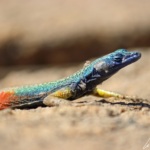
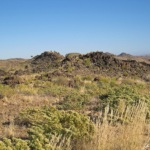
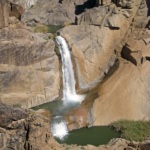
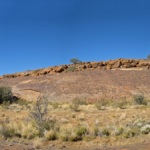
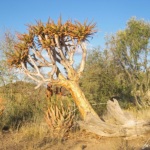
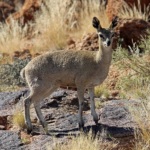
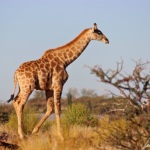
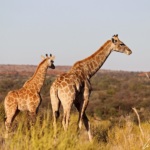
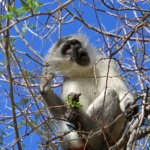
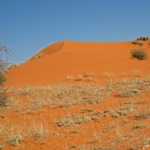


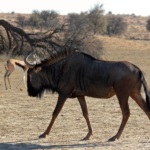
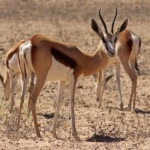
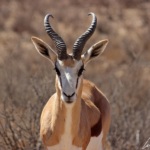

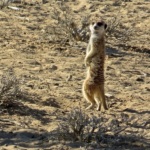
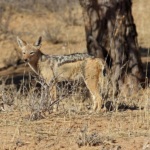
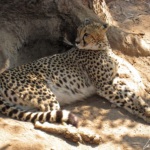

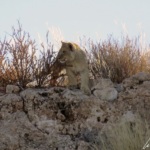


The first desert I ever went to was in Oman – last year. I must say it intrigued me. I’m meaning to maybe take in the Atacama when I (hopefully) pass through Chile end of this year. But I’ve not thought yet about Africa…
Crossing of the world’s largest salt flats – Uyuni (Bolivia) & Atacama (Chile) – rates as one of most impressive adventure I had in South America. I’m sure you will love your journey in North Chile !
This is such a great post! I’ve never been to South Africa but hopefully one day ✨ Also your pictures are so clear
Thank you :-). If you plan to go to South Africa, you should be prepared to travel in an ever-surprising country… surprising in its geography as well as in its diverse flora and fauna !
Wow. Your photos are absolutely stunning!! This looks like a magical, almost otherworldly place.
Thanks 🙂 This is definitively a magical area if you like Nature !
Beautiful shots! Dying to visit Africa again. Hoping to do South Africa, Tanzania and Kenya end of the year. I may sneak in a bit of Safari even though for this visit the aim is to be a beach bum 🙂
Wow, travel to South Africa, Tanzania & Kenya for the end of this year… It is an incredible travel plan :-). I’m sure you will love these places and not only as a beach bum !
Wow your photos are stunning- you got so close to the giraffes! AMAZING. What an incredible experience!
Indeed, it was an amazing experience 🙂
I loved your blogs. And the animals look spectacular. Adding it to me must-travel places with my daughter!
If you love Nature (landscape, flora and fauna), South Africa is definitively a place to visit. The vineyards and beaches of the Cape, the Cederberg peaks, the dry land of the Namakwa, the red dunes of the Kalahari, all this is only a glimpse of the great and beautiful, but also fragile, diversity of the country.
OMG!!!! What stunning photos! Africa is seriously calling my NAME! Objective Dune looks so lush and full of wildlife. I’m happy you had fun and had an opportunity to share such beautiful memories!
It was really an incredible journey 🙂
Augrabies Falls National Park looks amazing! I’ve lived in the desert before (Phoenix and Las Vegas) but we definitely lacked the wildlife you have here. I’ve never heard of this place before but Johannesburg is on my bucket list and I’m thinking I need to add this to that itinerary!
Augrabies Falls National Park unfolds in all its dramatic splendour ! The park has a network of gravel roads and trails tailor-made for wilderness thumping ! One of the best ways to explore this area is on foot. There are several hiking trails ranging from a few hours to three days 🙂
Awe, those giraffes are so adorable!!
I’ve always been curious about dunes!
Also, I can seriously imagine a lioness saying “I’m having an old friend for dinner” 😉 (HAHA) that quote perfectly fits in here!
We have been really lucky with the group of giraffes at the Augrabies Falls National Park 🙂 because the park covers an area of 320 square miles ! The lioness and her two lion cubs at Kalahari Desert were also a good surprise 🙂
Wow this sounds like a Nature loves dream! I would especially love to see the night time animals come out & am so jelly that you saw a cheetah & the lions! What an incredible experience!!
I am in constant awe of the beauty of life… I enjoy Mother Nature, more the country side over the city, the landscape to take your breath away rather than the skyscraper… and of course the fauna & flora 🙂
Wow, what an account of your time in this National Park. I can’t imagine how it would feel to be so close to these animals, I love how you had the animals quoting Harris too haha! I love the way you write. I will definitely check back when I eventually journey to South Africa 🙂
Indeed, it was an incredible experience to see all these different animals… and to be so close to them ! But I didn’t desire to develop a close relationship with the lioness and her two lion cubs… I didn’t want to become an old friend 🙂 🙂
This sounds like an incredible day! How awesome to see all of those different animals and wildlife in such a short amount of time. Will definitely have to think about this when I visit South Africa!
We have been quite lucky with the group of giraffes at the Augrabies Falls National Park… being at the right place at the right time :-). The lioness and her two lion cubs at Kalahari Desert were also an unexpected meeting… but such a good surprise !!
I love the sound of this trek and you’ve managed to get some wonderful photos of the wildlife. I can also see why it’s called moon rock!
One of the best ways to explore the Augrabies Falls National Park is on foot 🙂 There are several hiking trails ranging from a few hours to three days ! It was really a memorable hiking trail through the heart of one of South Africa’s most scenic national parks !!
Your photos are amazing! I love that waterfall but the colorful lizard takes the cake. What an awesome hike. You were able to see so much!
Thank you :-). The waterfalls are beautiful and we were so lucky to see all these animals ! It was such a great experience 🙂
I lived in SA for 6 years, I miss dearly the landscape. The pics are awesome and bring back sweet memories, thank you!
Nelson Mandela said famously, “There is nothing like returning to a place that remains unchanged to see the ways that you yourself have changed !”. I wish you could visit SA again to revisit the places of your past 🙂
What a wonderful experience! It’s a life long dream of mine to visit the Kalahari desert. I’m just fascinated by deserts and how certain species still manage to thrive there!
Jacky
I hope your dream will come true ! The Kalahari desert is an incredible place to visit 🙂
Awesome! South Africa is definitely on my wife and I’s wish list – it seems like such a magical place with amazing power in nature. Thanks for sharing you experience – it was fun read.
Thank you. South Africa is full of adventure, history, wildlife and great food ! It is a land people love to visit. And they have good reason 😉